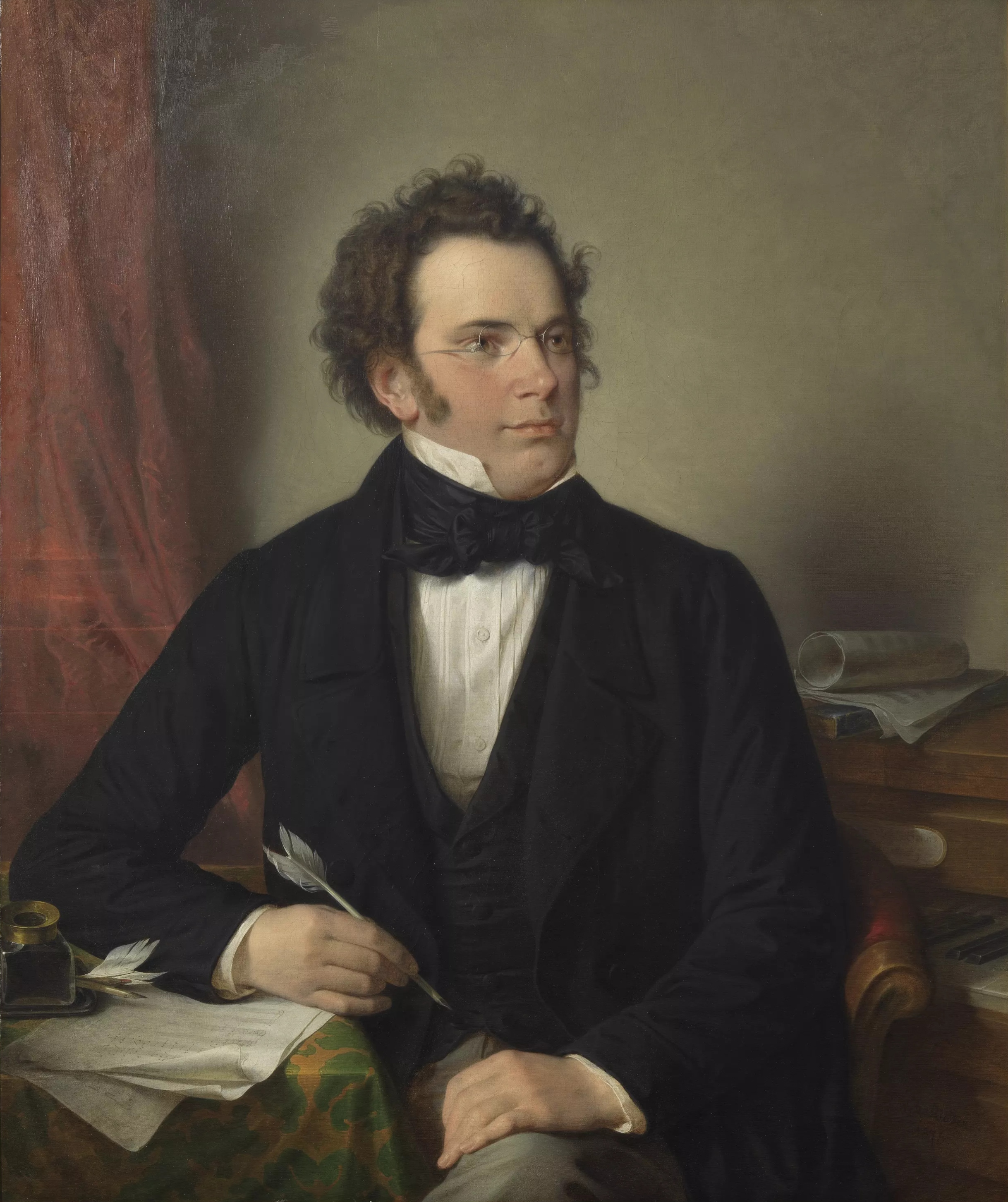슈베르트(Schubert)
(1797~1828/오스트리아)
String Quartet No. 13 in A minor (the Rosamunde Quartet), D. 804, Op. 29
Sini Simonen, Benjamin Bowman, Steven Dann, Richard Lester
at the 15th Esbjerg International Chamber Music Festival 2013. 25th August
at South Denmark's Music Academy,
The String Quartet No. 13 in A minor (the Rosamunde Quartet), D 804, Op. 29, was written by Franz Schubert between February and March 1824. It dates roughly to the same time as his monumental Death and the Maiden Quartet, emerging around three years after his previous attempt to write
for the string quartet genre, the Quartettsatz, D 703, that he never finished.(‘로자문데’라는 명칭은, 2악장 주제로 슈베르트 자신이 그 전해에 작곡한 극음악 <로자문데>의 3막과 4막 사이의 간주곡을 차용하고 있기 때문에 붙여진 것이다. 슈베르트는 이 선율을 특히 좋아해서 훗날 작곡하는 <즉흥환상곡> Op.142 3번에도 주제로 사용하였다. )
History
Starting in 1824, Schubert largely turned away from the composition of songs to concentrate on instrumental chamber music. In addition to the A-minor String Quartet, the Quartet in D minor, the Octet, the Grand Duo and Divertissement a la Hongroise (both for piano duet), and the Sonata for Arpeggione and Piano all date from that year. With the exception of the Grand Duo, all of these works display cyclic elements—that is, two or more movements in each work are deliberately related in some way to enhance the sense of unity. In the case of the A-minor Quartet, a motive from the third-movement Minuet becomes the most important melodic figure for the following finale (Chusid 1964, 37).
Schubert dedicated the work to Schuppanzigh, who served as the first violinist of the string quartet appointed by Beethoven. Schuppanzigh himself played in the premiere performance which took place on 14 March 1824.
Structure
Movements
The quartet consists of four movements which last around 30 minutes in total.
- Allegro ma non troppo
두 개의 주제를 사용한 고전 소나타 형식. 8분음표로 동요하는 2바이올린과 불안한 음형의 비올라와 첼로의 반주에 맞추어 아름답고 우수에 찬 제1주제를 1바이올린이 연주한다. 어두운 표정에 가득 찬 경과구를 거쳐 2바이올린에 의해 짧고 매혹적인 선율의 제2주제로 들어간다. 이후 제2주제의 동기를 이용한 코데타를 거쳐 제시부가 마감된다. D장조의 제1주제로 시작되는 발전부는 폴리포닉 서법을 중심으로 발전하여 클라이맥스에 이르는데 불안한 긴장감을 조성한다. 재현부는 정석대로 제2주제가 A장조로 나타나고 마지막은 제1주제에 의한 코다로 마감된다.
극음악 <로자문데>의 선율을 주제로 한 느린 악장. A-B-A'-B-A''의 론도 풍 형식이지만, 마지막 A''는 코다로 취급하고 있기 때문에 재현부가 발전부를 병행한 소나타 형식으로 볼 수 있다. 느리게 연주되는 이 아름다운 악장은 슈베르트의 선율 중에서도 가장 아름답다는 평판을 받고 있다. 제1주제는 1바이올린으로 연주되며 다른 현이 보기 좋게 대위법적인 반주를 한다. 다시 짧은 보조적인 주제가 제시된 후 얼마 후에 처음 주제가 재현한다. 전개부는 힘차게 발전되는데, 1바이올린에 의해 오르내리는 양상이 멋지다.
3. Menuetto: Allegretto – Trio :이 4중주곡에서 가장 특징적인 악장이다. 환상적이고 해학적인 무곡으로, 낮은 E음의 점8분음표에서 하행하고 D음의 16분음표에 이르러 다시 E음으로 돌아온다. 첼로의 낮은 음에서 시작하다가 그것이 끝나면 다른 현악기가 같은 음형을 연주한다. 트리오는 위안을 주는 듯한 역할을 하는데, 주제를 반복하면서 끝난다
4. Allegro moderato:
매혹적이고 화려하며 경쾌한 리듬이 기반을 이룬다. 이는 헝가리 풍 춤곡 선율인데, 두 개의 주제가 나타나며 주로 1바이올린이 제시부를 연주한다. 발전부에서는 우아하게 장식되어 시종 활기에 찬 분위기가 조성된다
Analysis
The first movement opens with a texture reminiscent of the melancholic theme from one of Schubert's earliest songs, Gretchen am Spinnrade and also quotes "Schöne Welt, wo bist du?" The reference to Gretchen am Spinnrade is not a direct quotation, but rather is a similarity in the second violin’s restless accompanimental figuration, hovering around the mediant and underpinned by a repeated figure in cello and viola, which precedes the first thematic entrance.
This also recalls the accompaniment to the first subject of the "Unfinished" Symphony (Westrup 1969, 31; Taylor 2014, 49). It is the second movement, however, which has lent the Quartet its nickname, being based on a theme from the incidental music for Rosamunde (a similar theme appears in the Impromptu in B-flat written three years later). The dactyl-spondee rhythm pervading this movement unmistakably shows the influence of Beethoven's Seventh Symphony (Temperley 1981, 149).
The form of this slow movement uses the same modified exposition-recapitulation form found in the slow movement of Schubert's "Great" C-major Symphony, where an ambiguity of formal definition is created by the introduction of a developmental passage shortly after the return of the primary theme in the recapitulation (Shamgar 2001, 154). The minuet quotes the melody of another song by
Schubert, Die Götter Griechenlands, D. 677, from November 1819, a connection only first noticed more than a century after the work's composition by Willi Kahl (1930, 2:358). The opening of this melody recurs in inversion at the beginning of the trio, and is later echoed in the opening of the finale (Wollenberg 2011, 201–202, n11).
Amadeus String Quartet
(Norbert Brainin - Siegmund Nissel - Peter Schidlof - Martin Lovett)
Studio recording, Hanover, 10-14.V.1954
'♣ 음악 감상실 ♣ > - 4중주(QUARET)' 카테고리의 다른 글
| Franz Schubert - String Quartet No. 15 in G major, D. 887 (0) | 2015.05.29 |
|---|---|
| Franz Schubert - String Quartet No 14 D minor Death and the Maiden (0) | 2015.05.28 |
| Schubert, String Quartet No 11,12, (0) | 2015.05.27 |
| 슈베르트(Schubert) String Quartet No 10 in e flat major op.125 No.1, D.87 (0) | 2015.05.26 |
| Schubert String Quartet No 8, 9, (0) | 2015.05.26 |
